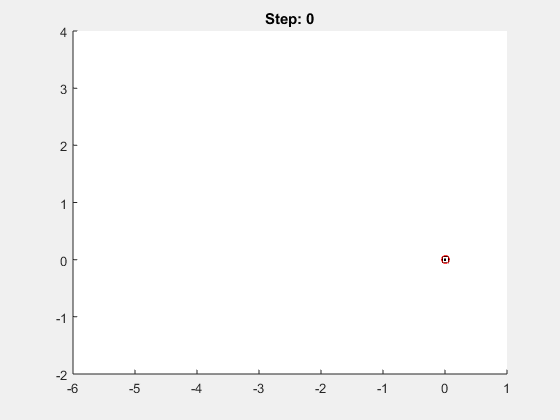Previously we described what a random walk is and demonstrated some simple code to perform this walk in one dimensional space. Today we will provide some simple code for how to perform such a walk in two-dimensional space. In the following post, we’ll look at the general case, and then we’ll get into some simulations. Here’s a sample of how our output will look like:
Just like before, we’ll first begin by initializing our function “random_walk”, do some simple argument error checking, and utilize MATLAB’s built-in “rand” and “round” functions.
% Random Walk in MATLAB
function position = random_walk(numSteps, numDimensions, plotResults)
% default values
if nargin < 3
plotResults = false;
end
if nargin < 2
numDimensions = 2;
end
% Use 40 as default number of steps
if nargin < 1
numSteps = 40;
end
% setup random walk values
randValues = round(rand(numSteps, numDimensions));
While in the one-dimensional case, we just had to worry about movement of -1 or 1 along the single axis, now we have four possibilities, specifically [1,0], [-1,0], [0,1], and [0,-1], in the (x,y) directions, respectively. Here’s how we will handle having these four possibilities. We’ll search through our array “randValues” and replace any (0,0) or (1,1) entries with (-1,0) and (0,-1). We can use the built-in MATLAB function repmat to do this for all instance of (0,0) or (1,1) in the array.
% One dimensional random walk
if numDimensions == 1
randValues(randValues == 0) = -1;
% Two dimensional random walk
elseif numDimensions == 2
% lets do the following conversions in 2D
% [0, 0] move backwards in x, i.e. [-1, 0]
negX = ismember(randValues,[0 0], 'rows');
randValues(negX,:) = repmat([-1 0], sum(negX), 1);
% [1, 0] move forwards in x
% [0, 1] move forwards in y
% [1, 1] move backwards in y, i.e [0, -1]
negY = ismember(randValues,[1 1], 'rows');
randValues(negY,:) = repmat([0 -1], sum(negY), 1);
end
Just like before, we now increment our position with each step:
% start at origin and initialize the position
position = zeros(numSteps+1, numDimensions);
for k = 2:numSteps+1
position(k,:) = position(k-1,:) + randValues(k-1,:);
end
and now the example we show at the beginning of this post is as follows:
position = random_walk(40,2,true)
position =
0 0
0 -1
-1 -1
-1 0
-1 1
-2 1
-2 2
-2 1
-2 0
-2 -1
-2 0
-3 0
-4 0
-3 0
-4 0
-4 1
-5 1
-4 1
-3 1
-2 1
-3 1
-2 1
-2 2
-1 2
-2 2
-2 1
-2 2
-3 2
-2 2
-1 2
-2 2
-2 1
-1 1
-1 2
-1 3
-2 3
-3 3
-2 3
-1 3
0 3
0 2
Stay tuned for more, and let us know if you have any comments!

